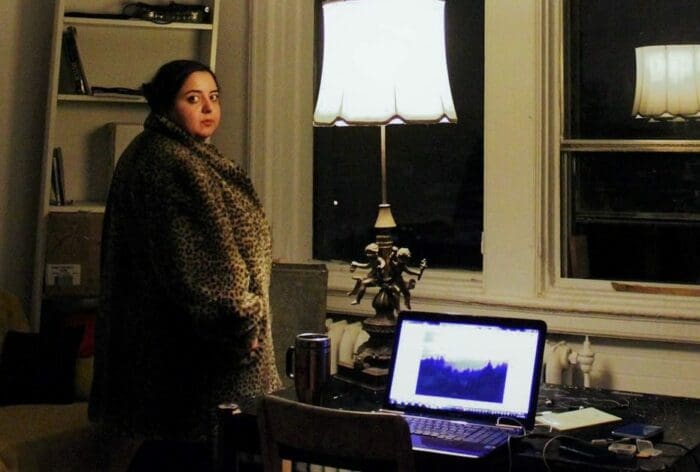 Before we announce the winners of the 2016 MyTheatre Awards, we’re proud to present our annual Nominee Interview Series.
Before we announce the winners of the 2016 MyTheatre Awards, we’re proud to present our annual Nominee Interview Series.
Shaista Latif’s The Archivist began in a deceptively light-hearted manner, with audience members, upon entering the theatre, being invited by Latif herself to pin-point a place on a map of the world that holds some special meaning for them, or which they hope to one day visit. The piece that followed, a one-woman memory play about Latif’s upbringing in the GTA and her struggle to reconcile her identity with the clashing influences in her life (her Kabul-born parents, her childhood growing up in Scarborough and Weston), maintained this conscious conversation with her audience, which is central both to the play’s structure and Latif’s beguilingly wry performance. A Toronto-based writer, director and actor, Latif’s other self-penned works include Graceful Rebellions and How I Learned to Serve Tea, and she has performed elsewhere while also facilitating multiple theatre workshops and working with Buddies in Bad Times and Cahoots Theatre Co, amongst other companies. This Outstanding New Work and Lighting & Sound Design– nominated production of The Archivist, which was produced as apart of Why Not Theatre’s RISER Project, was a strong and exciting indication of Latif’s dynamic presence in the Toronto theatre scene.
 Do you remember your first experience with theatre?
Do you remember your first experience with theatre?
No. Not really. What I remember is liking the feeling of hearing stories. Enjoying the way things unfolded and revealed themselves. Of course I didn’t have an understanding that what I was drawn to was called ‘theatre’ but I knew very early on that I liked watching the way people told stories, especially at family dinner parties and weddings. I think people who enjoy creating theatre are drawn to rituals. But if you want to get really real, I think re-enacting Young & Restless episodes with my troll dolls was probably my first experience with theatre.
You open yourself up to audience questions in The Archivist, and in general put a lot of faith in the audience to help guide parts of the evening, especially in the first half. How have you developed that particular aspect of the play over its various iterations, and have there been any instances or particular performances where a question really surprised you, or changed the path of the evening?
My practice is playing and playfulness. My role as an artist is to invite and push my own curiosity and interest with the audience’s. I put a lot of faith in the audience because I have a lot of faith in myself. I want to move with the energy of the room and the ability to know when and how to move is deeply instinctive. It can’t be taught. When you live as an othered body and know that you are not part of the dominant norm, you quickly learn how to read and respond to a room. I love making space for questions to be asked in the performance because it’s important for me to show that I am just as curious and invested in our time together. I also think it’s fascinating for audiences to witness responses in real time, with all the discomfort and humour of trying to answer what is often impossible to articulate fully within an hour! The thing is ‘Archivist’ is not a show and tell performance. I am not creating work to tell you what I learned because I don’t know anything. I am creating work to help recognize the conditions at play that impact and bind us all in certain systems. Questions for me is a way to help humanize the act of telling and I’m always surprised by the questions.
Can you describe how the show has changed over time? What has dictated that?
My process dictates the changes so do my resources. Originally the show used a lecture format with minimal projected images and chalk to outline my relationship to time and displacement. Then for the Theatre Centre showings, I decided to create installations and to work with archival objects while actively changing the structure of the show and the audience configuration each night. Absolutely absurd right? But it was incredibly crucial for my artistic growth. Changes can’t take place or be explored without practical support. I’m really grateful to have been programmed part of Why Not Theatre’s RISER Project. I had recently walked away from a residency and experienced some precarity and loss with employment as well, so having meaningful support to experiment without financial jeopardy was an absolute blessing at the right time. This show in particular represents my approach to working in a medium that is deeply challenged and conflicted by issues of class and inclusion. The changes that have come from the evolution of my practice has been based on how I make use of what is available both creatively and mentally. Working within my means without resorting to debt or compromising my values as an artist as a means of attaining success and legitimization has become a necessary tactic of survival. I only want to show the work when the process calls for it. I have no intention of working within the known and common trajectory of how work is usually programmed from inception, rehearsal hall to the stage. I am attempting to decolonize my art practice and avoid as much as possible working within structures that cause harm for marginalized bodies.
What do you hope people take away from the performance?
I have no hope for the people. I’m kidding! Well this question is a hard one. My hope is that the audience recognizes themselves in the story. Yes I understand this work is based on my real lived experiences. Yes it does track my family’s displacement and my own but it is not my story. It is not my family’s story. It is a story. What I am trying to do as an artist is to show the conditions that are placed onto us and how we all grapple and live under the extremes of these conditions. There is no reconciliation with this work. There will be no reconciliation with my future works. I think my ambition is to make space for us to talk about how we make meaning, have joy and awareness without clear answers and certainty.
As a one-woman show, this play requires you not only to be very exposed but also to be front-and-center for the entire hour. Has working on The Archivist changed your perceptions of yourself as a performer at all? Has it re-oriented any ambitions you had for yourself as an actor and writer, in terms of what you want to work on in the future?
Of course an artist has to be strategic in finding ways to continue making work and receiving funding but I’ve learned that I am not one to rush a process in order to maintain a visible position within the community. I think there is too much pressure for artists to produce constantly. It creates an unhealthy relationship to the work when your creativity has to be commodified before it’s given a chance to develop and grow naturally. Having experienced exclusion due to my lack of formal education, my gender and class has taught me to be resilient with this work. I am proud of my resiliency as a self taught artist. It’s not easy to work mostly alone and historically, many female artists don’t get a chance to work with large teams. Thankfully over the years I’ve been able to attain mentorship with senior artists who care for my work and my day to day existence. While creating and performing Archivist I have come to recognize certain ways of working in order to cultivate agency. I think I have lost my illusions about the industry which has given me freedom to do what is necessary for my work. I am creating without apology or fear. Here’s the thing, if I am serving the work and the process, I am doing my job. This is what counts most for me.
In addition to New Work, you’re nominated for the lighting and sound design of the show. Tell us a little bit about that process and working with your collaborators Andre Du Toit & Pip Bradford.
Deciding to create my own lighting and sound design with the guidance of Andre Du Toit was about working within my means and my limitations. I also love challenging myself to learn new things. I told Andre my intentions and he showed up with a bag of awesome lighting goodies and I dived in. The lighting also changed each night as well, depending on the level of intimacy needed and the audience configuration. He was super supportive in allowing me to figure out what worked best for my process. Pip was exceptional in her ability to go with and support the changes. She would follow along and hold the transitions with amazing humour and grace. This was not an easy show for both of them to manage but they did it with a great deal of care. I was very grateful for the ways they took the time to understand my intentions.
Did you have a favourite moment in the production?
Each time I heard laughter. Each time I felt us all breathing together.
What are you doing now/ what’s your next project?
I am working on my projects Kabul Punk, How I Learned to Serve Tea and Archivist. I am an Artist in Residence at STO Union under the guidance of Nadia Ross. I am preparing for my upcoming exhibits. I am writing. I am getting published. I am redirecting the focus of my practice. I am re-engaging with my communities. I am learning to centre my experiences as a person of colour. I am finding ways to speak about the inseparable relationship between class and race.
Do you have anything you’d like to add?
I am very happy that the work touched you enough to nominate Archivist. There are many outstanding productions that take place every week in this city. I am proud of the community I am part of and support. I am grateful for the recognition of my work. Thank you.
